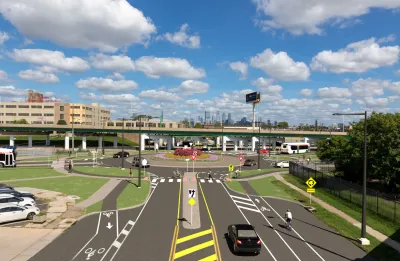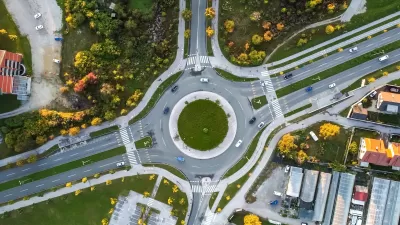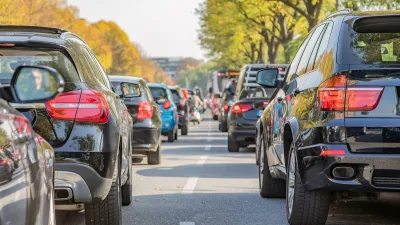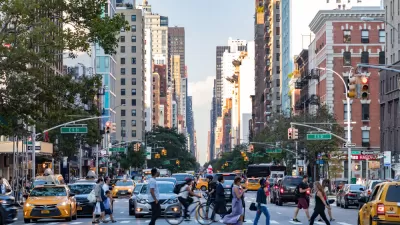Roundabouts are widely shown to decrease traffic speed, reduce congestion, and improve efficiency.

Philadelphia is expanding its system of roundabouts, becoming one of a growing number of U.S. cities to introduce the intersection design widely popular in the rest of the world.
As Leo Miranda explains in an article for WHYY, “Traffic safety data and experts say roundabouts are safer and more efficient than traditional intersections. The round shape slows traffic and creates a simpler flow, reducing the chance of serious accidents by eliminating complex turns and merging.” Roundabouts also create smoother traffic flow and increase cars’ fuel efficiency while improving safety. Miranda explains the differences between roundabouts and larger traffic circles or rotaries, which have merging lanes and often have signals or stop signs.
Philadelphia’s newest roundabout, the Penrose Roundabout, will replace a large signalized intersection. “The intersection is included in Philadelphia’s ‘High Injury Network’ of dangerous roads — part of Vision Zero, the city’s effort to target streets with many traffic crashes.”
The wider adoption of roundabouts may just be a matter of time: “A nationwide study found that the longer a roundabout is in place, the more supportive drivers become; around a third of drivers surveyed said they did not like roundabouts, but support jumped to over 50% after roundabouts were installed.”
FULL STORY: Penrose Roundabout is South Philly’s newest traffic-calming effort

Planetizen Federal Action Tracker
A weekly monitor of how Trump’s orders and actions are impacting planners and planning in America.

Congressman Proposes Bill to Rename DC Metro “Trump Train”
The Make Autorail Great Again Act would withhold federal funding to the system until the Washington Metropolitan Area Transit Authority (WMATA), rebrands as the Washington Metropolitan Authority for Greater Access (WMAGA).

The Simple Legislative Tool Transforming Vacant Downtowns
In California, Michigan and Georgia, an easy win is bringing dollars — and delight — back to city centers.

The States Losing Rural Delivery Rooms at an Alarming Pace
In some states, as few as 9% of rural hospitals still deliver babies. As a result, rising pre-term births, no adequate pre-term care and harrowing close calls are a growing reality.

The Small South Asian Republic Going all in on EVs
Thanks to one simple policy change less than five years ago, 65% of new cars in this Himalayan country are now electric.

DC Backpedals on Bike Lane Protection, Swaps Barriers for Paint
Citing aesthetic concerns, the city is removing the concrete barriers and flexposts that once separated Arizona Avenue cyclists from motor vehicles.
Urban Design for Planners 1: Software Tools
This six-course series explores essential urban design concepts using open source software and equips planners with the tools they need to participate fully in the urban design process.
Planning for Universal Design
Learn the tools for implementing Universal Design in planning regulations.
Smith Gee Studio
City of Charlotte
City of Camden Redevelopment Agency
City of Astoria
Transportation Research & Education Center (TREC) at Portland State University
US High Speed Rail Association
City of Camden Redevelopment Agency
Municipality of Princeton (NJ)





























